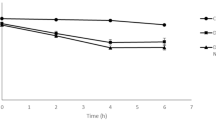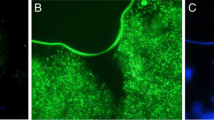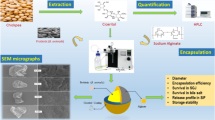Abstract
Microencapsulation enhances the oral delivery of probiotic bacteria. In this study, the probiotic Escherichia coli Nissle 1917 (EcN) was microencapsulated using alginate and chitosan nanoparticles. The result showed 90% encapsulation yield of EcN, and the encapsulated EcN displayed significantly (P < 0.05) increased survival in low pH (1.5), high bile salt concentration (4%), and high temperature (70 °C). The most effective cryopreservatives of EcN during freezing and thawing was skim milk and sucrose. Exposure to microencapsulated EcN significantly (P < 0.05) reduced the Campylobacter jejuni growth by 2 log CFU. The rate of EcN release from microcapsule was 9.2 × 105 cell min−1, and the appropriate model to describe its release kinetics was zero order. Importantly, the entrapment of EcN inside the microcapsule did not eliminate the exterior diffusion of EcN produced antioxidant compounds. In addition, the EcN microcapsule efficiently adhered to intestinal HT-29 cells and the pre-treatment of HT-29 cells with EcN-microcapsule for 4 h significantly (P < 0.05) reduced the invasion (1.9 log) of C. jejuni; whereas, completely abolished the intracellular survival. Furthermore, HT-29 cells pre-treated with encapsulated EcN in PCR array showed decreased expression (> 1.5-fold) of genes encoding chemokines, toll-like receptors, interleukins, and tumor necrosis factors. In conclusion, the alginate-chitosan microcapsule can provide effectual platform to deliver probiotic EcN and thereby can reduce the Campylobacter infection in chickens and humans.






Similar content being viewed by others
References
Alemka A, Clyne M, Shanahan F, Tompkins T, Corcionivoschi N, Bourke B (2010) Probiotic colonization of the adherent mucus layer of HT29MTXE12 cells attenuates Campylobacter jejuni virulence properties. Infect Immun 78(6):2812–2822
Allie N, Grivennikov SI, Keeton R, Hsu N-J, Bourigault M-L, Court N, Fremond C, Yeremeev V, Shebzukhov Y, Ryffel B, Nedospasov SA, Quesniaux VFJ, Jacobs M (2013) Prominent role for T cell-derived tumour necrosis factor for sustained control of Mycobacterium tuberculosis infection. Sci Rep 3:1809. https://doi.org/10.1038/srep01809
Anal AK, Singh H (2007) Recent advances in microencapsulation of probiotics for industrial applications and targeted delivery. Trends Food Sci Technol 18(5):240–251
Andersen T, Markussen C, Dornish M, Heier-Baardson H, Melvik JE, Alsberg E, Christensen BE (2014) In situ gelation for cell immobilization and culture in alginate foam scaffolds. Tissue Eng A 20(3–4):600–610. https://doi.org/10.1089/ten.tea.2013.0223
Barichella M, Pacchetti C, Bolliri C, Cassani E, Iorio L, Pusani C, Pinelli G, Privitera G, Cesari I, Faierman SA (2016) Probiotics and prebiotic fiber for constipation associated with Parkinson disease an RCT. Neurology 87(12):1274–1280
Behnsen J, Deriu E, Sassone-Corsi M, Raffatellu M (2013) Probiotics: properties, examples, and specific applications. CSH Pespect Med 3(3):a010074
Bielinska AU, Makidon PE, Janczak KW, Blanco LP, Swanson B, Smith DM, Pham T, Szabo Z, Kukowska-Latallo JF, Baker JR Jr (2014) Distinct pathways of humoral and cellular immunity induced with the mucosal administration of a nanoemulsion adjuvant. J Immunol 192(6):2722–2733. https://doi.org/10.4049/jimmunol.1301424
Cao X, Lin H, Muskhelishvili L, Latendresse J, Richter P, Heflich RH (2015) Tight junction disruption by cadmium in an in vitro human airway tissue model. Respir Res 16:30. https://doi.org/10.1186/s12931-015-0191-9
Carneiro-da-Cunha MG, Cerqueira MA, Souza BW, Carvalho S, Quintas MA, Teixeira JA, Vicente AA (2010) Physical and thermal properties of a chitosan/alginate nanolayered PET film. Carbohydr Polym 82(1):153–159
Chang S-H, Lin H-TV, Wu G-J, Tsai GJ (2015) pH effects on solubility, zeta potential, and correlation between antibacterial activity and molecular weight of chitosan. Carbohydr Polym 134:74–81. https://doi.org/10.1016/j.carbpol.2015.07.072
Chávarri M, Marañón I, Ares R, Ibáñez FC, Marzo F, Villarán MC (2010) Microencapsulation of a probiotic and prebiotic in alginate-chitosan capsules improves survival in simulated gastro-intestinal conditions. Int J Food Microbiol 142(1):185–189. https://doi.org/10.1016/j.ijfoodmicro.2010.06.022
Cook MT, Tzortzis G, Charalampopoulos D, Khutoryanskiy VV (2012) Microencapsulation of probiotics for gastrointestinal delivery. J Control Release 162(1):56–67
Dash V, Mishra SK, Singh M, Goyal AK, Rath G (2010) Release kinetic studies of aspirin microcapsules from ethyl cellulose, cellulose acetate phthalate and their mixtures by emulsion solvent evaporation method. Sci Pharm 78(1):93–101. https://doi.org/10.3797/scipharm.0908-09
De Giulio B, Orlando P, Barba G, Coppola R, De Rosa M, Sada A, De Prisco P, Nazzaro F (2005) Use of alginate and cryo-protective sugars to improve the viability of lactic acid bacteria after freezing and freeze-drying. World J Microbiol Biotechnol 21(5):739–746
Duncan TV (2011) Applications of nanotechnology in food packaging and food safety: barrier materials, antimicrobials and sensors. J Colloid Interface Sci 363(1):1–24
Fuentes-Zaragoza E, Sánchez-Zapata E, Sendra E, Sayas E, Navarro C, Fernández-López J, Pérez-Alvarez JA (2011) Resistant starch as prebiotic: a review. Starch - Stärke 63(7):406–415. https://doi.org/10.1002/star.201000099
Gangaiah D, Liu Z, Arcos J, Kassem II, Sanad Y, Torrelles JB, Rajashekara G (2010) Polyphosphate kinase 2: a novel determinant of stress responses and pathogenesis in Campylobacter jejuni. PLoS One 5(8):e12142
Gasperini L, Mano JF, Reis RL (2014) Natural polymers for the microencapsulation of cells. J Royal Soc Interface 11(100):20140817. https://doi.org/10.1098/rsif.2014.0817
Gbassi GK, Vandamme T (2012) Probiotic encapsulation technology: from microencapsulation to release into the gut. Pharmaceutics 4(1):149–163
Goldenberg JZ, Ma SS, Saxton JD, Martzen MR, Vandvik PO, Thorlund K, Guyatt GH, Johnston BC (2013) Probiotics for the prevention of Clostridium difficile-associated diarrhea in adults and children. Cochrane Database Syst Rev 12:CD006095
Gotoh T, Matsushima K, Kikuchi K-I (2004) Preparation of alginate–chitosan hybrid gel beads and adsorption of divalent metal ions. Chemosphere 55(1):135–140. https://doi.org/10.1016/j.chemosphere.2003.11.016
Grozdanov L, Zähringer U, Blum-Oehler G, Brade L, Henne A, Knirel YA, Schombel U, Schulze J, Sonnenborn U, Gottschalk G, Hacker J, Rietschel ET, Dobrindt U (2002) A single nucleotide exchange in the wzy gene is responsible for the Semirough O6 lipopolysaccharide phenotype and serum sensitivity of Escherichia coli strain Nissle 1917. J Bacteriol 184(21):5912–5925. https://doi.org/10.1128/JB.184.21.5912-5925.2002
Helmy YA, Kassem II, Kumar A, Rajashekara G (2017) In vitro evaluation of the impact of the probiotic E. coli Nissle 1917 on Campylobacter jejuni’s invasion and intracellular survival in human colonic cells. Front Microbiol 8(1588). https://doi.org/10.3389/fmicb.2017.01588
Henker J, Laass MW, Blokhin BM, Maydannik VG, Bolbot YK, Elze M, Wolff C, Schreiner A, Schulze J (2008) Probiotic Escherichia coli Nissle 1917 versus placebo for treating diarrhea of greater than 4 days duration in infants and toddlers. Pediatr Infect Dis J 27(6):494–499
Huebner C, Ding Y, Petermann I, Knapp C, Ferguson LR (2011) The probiotic Escherichia coli Nissle 1917 reduces pathogen invasion and modulates cytokine expression in Caco-2 cells infected with Crohn’s disease-associated E. coli LF82. Appl Environ Microbiol 77(7):2541–2544. https://doi.org/10.1128/aem.01601-10
Joeres-Nguyen-Xuan TH, Boehm SK, Joeres L, Schulze J, Kruis W (2010) Survival of the probiotic Escherichia coli Nissle 1917 (EcN) in the gastrointestinal tract given in combination with oral mesalamine to healthy volunteers. Inflamm Bowel Dis 16(2):256–262. https://doi.org/10.1002/ibd.21042
Kailasapathy K (2014) Microencapsulation for gastrointestinal delivery of probiotic bacteria. In: Nano-and microencapsulation for foods, pp 167–197
Kanmani P, Kumar RS, Yuvaraj N, Paari K, Pattukumar V, Arul V (2011) Cryopreservation and microencapsulation of a probiotic in alginate-chitosan capsules improves survival in simulated gastrointestinal conditions. Biotechnol Bioprocess Eng 16(6):1106–1114
Kassem II, Khatri M, Esseili MA, Sanad YM, Saif YM, Olson JW, Rajashekara G (2012) Respiratory proteins contribute differentially to Campylobacter jejuni’s survival and in vitro interaction with hosts’ intestinal cells. BMC Microbiol 12(1):258
Kedare SB, Singh RP (2011) Genesis and development of DPPH method of antioxidant assay. J Food Sci Technol 48(4):412–422. https://doi.org/10.1007/s13197-011-0251-1
Kelly C, Gundogdu O, Pircalabioru G, Cean A, Scates P, Linton M, Pinkerton L, Magowan E, Stef L, Simiz E (2017) The in vitro and in vivo effect of carvacrol in preventing Campylobacter infection, colonization and in improving productivity of chicken broilers. Foodborne Pathog Dis 14(6):341–349
Khosravi Zanjani MA, Ghiassi Tarzi B, Sharifan A, Mohammadi N (2014) Microencapsulation of probiotics by calcium alginate-gelatinized starch with chitosan coating and evaluation of survival in simulated human gastro-intestinal condition. Iran J Pharm Res 13(3):843–852
Kim I-Y, Seo S-J, Moon H-S, Yoo M-K, Park I-Y, Kim B-C, Cho C-S (2008) Chitosan and its derivatives for tissue engineering applications. Biotechnol Adv 26(1):1–21
Korlath JA, Osterholm MT, Judy LA, Forfang JC, Robinson RA (1985) A point-source outbreak of campylobacteriosis associated with consumption of raw milk. J Infect Dis 152(3):592–596
Krasaekoopt W, Bhandari B, Deeth HC (2006) Survival of probiotics encapsulated in chitosan-coated alginate beads in yoghurt from UHT-and conventionally treated milk during storage. LWT Food Sci Technol 39(2):177–183
Kumar M, Nagpal R, Kumar R, Hemalatha R, Verma V, Kumar A, Chakraborty C, Singh B, Marotta F, Jain S (2012) Cholesterol-lowering probiotics as potential biotherapeutics for metabolic diseases. Exp Diabetes Res 2012:1–14
Lau CSM, Chamberlain RS (2016) Probiotics are effective at preventing Clostridium difficile-associated diarrhea: a systematic review and meta-analysis. Int J Gen Med 9:27–37. https://doi.org/10.2147/IJGM.S98280
Lee KY, Mooney DJ (2012) Alginate: properties and biomedical applications. Prog Polym Sci 37(1):106–126. https://doi.org/10.1016/j.progpolymsci.2011.06.003
Liu M, Zhong X, Yang Z (2017) Chitosan functionalized nanocochleates for enhanced oral absorption of cyclosporine A. Sci Rep 7:41322. https://doi.org/10.1038/srep41322
Lorevice MV, Otoni CG, de Moura MR, Mattoso LHC (2016) Chitosan nanoparticles on the improvement of thermal, barrier, and mechanical properties of high-and low-methyl pectin films. Food Hydrocoll 52:732–740
Martin MJ, Lara-Villoslada F, Ruiz MA, Morales ME (2015) Microencapsulation of bacteria: a review of different technologies and their impact on the probiotic effects. Innov Food Sci Emerg Technol 27:15–25
Mishima Y, Amano Y, Takahashi Y, Mishima Y, Moriyama N, Miyake T, Ishimura N, Ishihara S, Kinoshita Y (2009) Gastric emptying of liquid and solid meals at various temperatures. J Gastroenterol 44(5):412–418. https://doi.org/10.1007/s00535-009-0022-1
Mogensen TH (2009) Pathogen recognition and inflammatory signaling in innate immune defenses. Clin Microbiol Rev 22(2):240–273. https://doi.org/10.1128/CMR.00046-08
Navarro JB, Mashburn-Warren L, Bakaletz LO, Bailey MT, Goodman SD (2017) Enhanced probiotic potential of Lactobacillus reuteri when delivered as a biofilm on dextranomer microspheres that contain beneficial cargo. Front Microbiol 8
Oskouei DD, Bekmen N, Ellidokuz H, Yılmaz Ö (2010) Evaluation of different cryoprotective agents in maintenance of viability of Helicobacter pylori in stock culture media. Braz J Microbiol 41(4):1038–1046. https://doi.org/10.1590/S1517-838220100004000023
Pandey S, Singh A, Kumar P, Chaudhari A, Nareshkumar G (2014) Probiotic Escherichia coli CFR 16 producing pyrroloquinoline quinone (PQQ) ameliorates 1, 2-dimethylhydrazine-induced oxidative damage in colon and liver of rats. Appl Biochem Biotechnol 173(3):775–786
Plaza-Díaz J, Ruiz-Ojeda FJ, Vilchez-Padial LM, Gil A (2017) Evidence of the anti-inflammatory effects of probiotics and Synbiotics in intestinal chronic diseases. Nutrients 9(6):555. https://doi.org/10.3390/nu9060555
Reissbrodt R, Hammes WP, Dal Bello F, Prager R, Fruth A, Hantke K, Rakin A, Starcic-Erjavec M, Williams PH (2008) Inhibition of growth of Shiga toxin-producing Escherichia coli by nonpathogenic Escherichia coli. FEMS Microbiol Lett 290(1):62–69
Rokka S, Rantamäki P (2010) Protecting probiotic bacteria by microencapsulation: challenges for industrial applications. Eur Food Res Technol 231(1):1–12
Sahoo M, Ceballos-Olvera I, del Barrio L, Re F (2011) Role of the Inflammasome, IL-1. Sci World J 11:2037–2050
Scaldaferri F, Gerardi V, Mangiola F, Lopetuso LR, Pizzoferrato M, Petito V, Papa A, Stojanovic J, Poscia A, Cammarota G (2016) Role and mechanisms of action of Escherichia coli Nissle 1917 in the maintenance of remission in ulcerative colitis patients: an update. World J Gastroenterol 22(24):5505–5511
Schierack P, Kleta S, Tedin K, Babila JT, Oswald S, Oelschlaeger TA, Hiemann R, Paetzold S, Wieler LH (2011) E. coli Nissle 1917 affects Salmonella adhesion to porcine intestinal epithelial cells. PLoS One 6(2):e14712. https://doi.org/10.1371/journal.pone.0014712
Schultz M, Burton JP (2017) Chapter 5 Escherichia coli Nissle 1917. In: The microbiota in gastrointestinal pathophysiology, pp 59–69
Shori AB (2017) Microencapsulation improved probiotics survival during gastric transit. HAYATI J Biosci 24(1):1–5. https://doi.org/10.1016/j.hjb.2016.12.008
Singh SJ, Gibbons NJ, Blackshaw P, Vincent M, Walker J, Perkins AC (2006) Gastric emptying of solids in normal children—a preliminary report. J Pediatr Surg 41(2):413–417
Solanki HK, Pawar DD, Shah DA, Prajapati VD, Jani GK, Mulla AM, Thakar PM (2013) Development of microencapsulation delivery system for long-term preservation of probiotics as biotherapeutics agent. Biomed Res Int 2013:620719–620721. https://doi.org/10.1155/2013/620719
Sonnenborn U (2016) Escherichia coli strain Nissle 1917—from bench to bedside and back: history of a special Escherichia coli strain with probiotic properties. FEMS Microbiol Lett 363(19):fnw212–fnw212. https://doi.org/10.1093/femsle/fnw212
Sonnenborn U, Schulze J (2009) The non-pathogenic Escherichia coli strain Nissle 1917–features of a versatile probiotic. Microb Ecol Health Dis 21(3–4):122–158
Stokes NR, Zhou X, Meltzer SJ, Kaper JB (2004) Transcriptional responses of intestinal epithelial cells to infection with Vibrio cholerae. Infect Immun 72(7):4240–4248
Trebichavsky I, Splichal I, Rada V, Splichalova A (2010) Modulation of natural immunity in the gut by Escherichia coli strain Nissle 1917. Nutr Rev 68(8):459–464
Turner MD, Nedjai B, Hurst T, Pennington DJ (2014) Cytokines and chemokines: at the crossroads of cell signalling and inflammatory disease. Biochim Biophys Acta 1843(11):2563–2582. https://doi.org/10.1016/j.bbamcr.2014.05.014
Ukena SN, Singh A, Dringenberg U, Engelhardt R, Seidler U, Hansen W, Bleich A, Bruder D, Franzke A, Rogler G, Suerbaum S, Buer J, Gunzer F, Westendorf AM (2007) Probiotic Escherichia coli Nissle 1917 inhibits leaky gut by enhancing mucosal integrity. PLoS One 2(12):e1308. https://doi.org/10.1371/journal.pone.0001308
Weise C, Zhu Y, Ernst D, Kuhl AA, Worm M (2011) Oral administration of Escherichia coli Nissle 1917 prevents allergen-induced dermatitis in mice. Exp Dermatol 20(10):805–809. https://doi.org/10.1111/j.1600-0625.2011.01326.x
Xing J, Wang G, Zhang Q, Liu X, Gu Z, Zhang H, Chen YQ, Chen W (2015) Determining antioxidant activities of lactobacilli cell-free supernatants by cellular antioxidant assay: a comparison with traditional methods. PLoS One 10(3):e0119058
Yeung TW, Üçok EF, Tiani KA, McClements DJ, Sela DA (2016) Microencapsulation in alginate and chitosan microgels to enhance viability of Bifidobacterium longum for oral delivery. Front Microbiol 7(494). https://doi.org/10.3389/fmicb.2016.00494
Younes I, Rinaudo M (2015) Chitin and chitosan preparation from marine sources. Structure, properties and applications. Mar Drugs 13(3):1133–1174. https://doi.org/10.3390/md13031133
Zanjani MAK, Tarzi BG, Sharifan A, Mohammadi N (2014) Microencapsulation of probiotics by calcium alginate-gelatinized starch with chitosan coating and evaluation of survival in simulated human gastro-intestinal condition. Iran J Pharm Res 13(3):843
Zárate G, Nader-Macias ME (2006) Viability and biological properties of probiotic vaginal lactobacilli after lyophilization and refrigerated storage into gelatin capsules. Process Biochem 41(8):1779–1785
Zhang Y, Feustel PJ, Kimelberg HK (2006) Neuroprotection by pyrroloquinoline quinone (PQQ) in reversible middle cerebral artery occlusion in the adult rat. Brain Res 1094(1):200–206
Zyrek AA, Cichon C, Helms S, Enders C, Sonnenborn U, Schmidt MA (2007) Molecular mechanisms underlying the probiotic effects of Escherichia coli Nissle 1917 involve ZO-2 and PKCζ redistribution resulting in tight junction and epithelial barrier repair. Cell Microbiol 9(3):804–816
Acknowledgements
We thank Dr. Tea Meulia, Molecular and Cellular Imaging Center (https://mcic.osu.edu/home), Ohio Agricultural Research and Development Centrer (OARDC), The Ohio State University for providing assistance with confocal microscopy analyses.
Funding
Research in Dr. Rajashekara’s laboratory was supported by funding from National Institute for Food and Agriculture (NIFA), U.S. Department of Agriculture, National Institute of Health, and Federal and State funds appropriated to the OARDC. Dr. Asmaa Mawad was supported by the Egyptian Ministry of Higher Education.
Author information
Authors and Affiliations
Corresponding author
Ethics declarations
Conflict of interest
The authors declare that they have no competing interest.
Ethical approval
This article does not contain any studies with human participants or animals.
Rights and permissions
About this article
Cite this article
Mawad, A., Helmy, Y.A., Shalkami, AG. et al. E. coli Nissle microencapsulation in alginate-chitosan nanoparticles and its effect on Campylobacter jejuni in vitro. Appl Microbiol Biotechnol 102, 10675–10690 (2018). https://doi.org/10.1007/s00253-018-9417-3
Received:
Revised:
Accepted:
Published:
Issue Date:
DOI: https://doi.org/10.1007/s00253-018-9417-3




